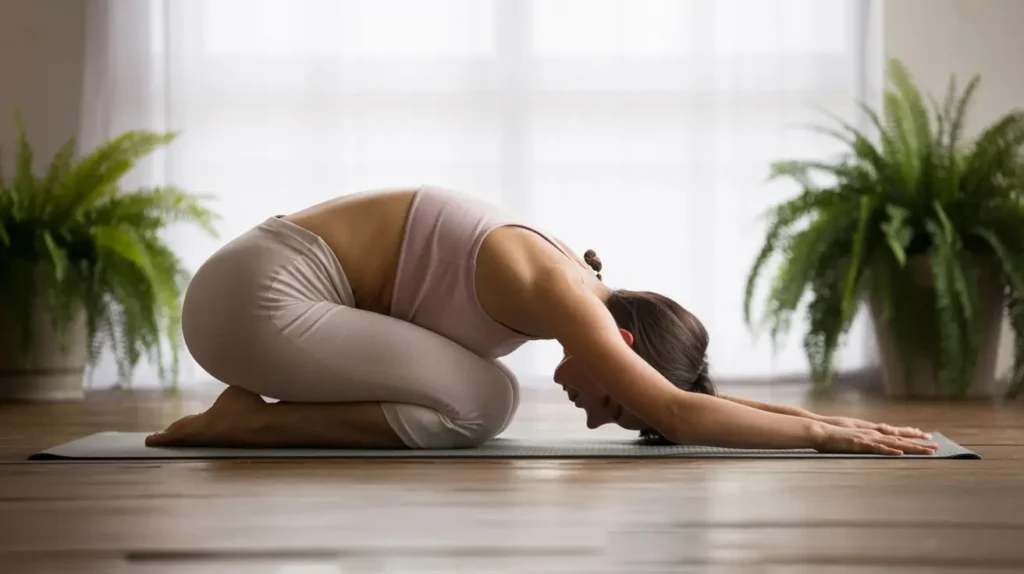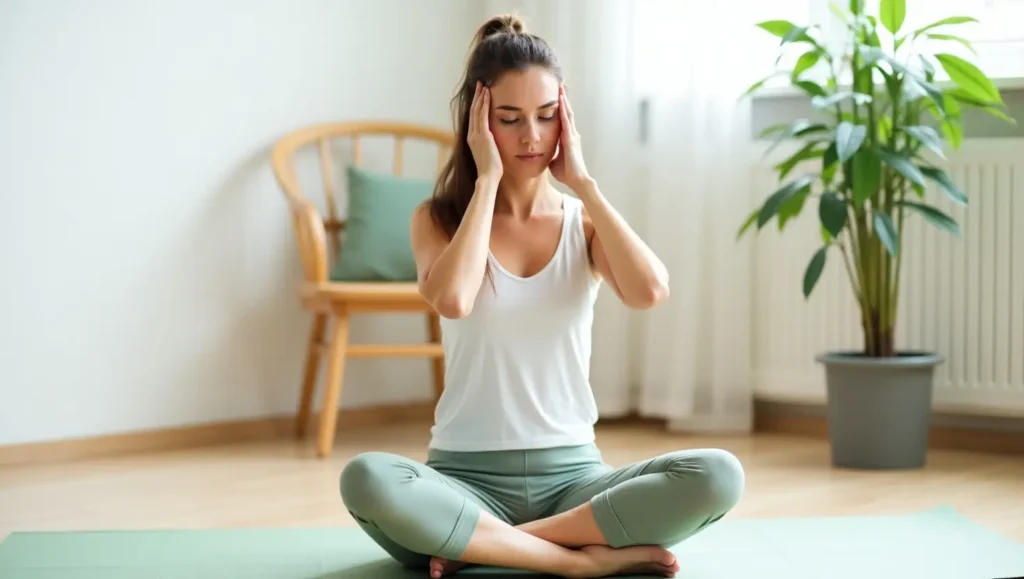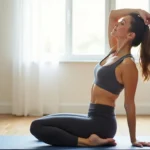Introduction
Stress is an inevitable part of modern life. From work deadlines to personal responsibilities and the constant buzz of digital notifications, it’s easy to feel overwhelmed. Chronic stress doesn’t just affect our mental health—it can lead to fatigue, headaches, poor sleep, anxiety, and even chronic disease. Fortunately, yoga offers a natural and effective way to manage stress. This blog explores 11 powerful yoga poses for stress relief that you can practice daily to feel more grounded, centered, and calm.
1. Child’s Pose (Balasana)
Why it works: This gentle resting pose soothes the brain, stretches the lower back, and helps release tension in the shoulders and spine. (yoga poses for stress relief).
How to do it: Kneel on the mat, touch your big toes together, sit back on your heels, and stretch your arms forward. Rest your forehead on the mat and breathe deeply for 1–3 minutes.
Pro Tip: Use a bolster or pillow under your chest if you need extra support.

2. Cat-Cow Pose (Marjaryasana-Bitilasana)
Why it works: This flowing movement between two postures warms up the spine and improves breath awareness, helping you to release pent-up tension.(yoga poses for stress relief).
How to do it: Begin on your hands and knees. Inhale and arch your back (Cow Pose), then exhale and round it (Cat Pose). Repeat for 1–2 minutes.
Bonus: It’s especially beneficial after a long day of sitting.
3. Forward Fold (Uttanasana)
Why it works: Folding forward calms the nervous system and encourages introspection. It also stretches the hamstrings and lower back. (yoga poses for stress relief).
How to do it: Stand with feet hip-width apart. Exhale and hinge from the hips to fold forward, allowing your head to hang heavy. Hold for 1–2 minutes.
Tip: Bend your knees if your hamstrings are tight.
4. Legs-Up-the-Wall (Viparita Karani)
Why it works: This restorative inversion calms the nervous system, reduces fatigue, and promotes circulation. (yoga poses for stress relief).
How to do it: Sit next to a wall, lie back, and swing your legs up the wall. Rest your arms by your sides. Stay in the pose for 5–10 minutes.
Helpful for: Insomnia, anxiety, and swollen feet.
5. Reclined Bound Angle Pose (Supta Baddha Konasana)
Why it works: Opens the hips and chest, areas where many store emotional tension. It’s deeply calming for the mind and body. (yoga poses for stress relief).
How to do it: Lie on your back, bring the soles of your feet together, and let your knees fall apart. Place pillows or blocks under your knees for support. Close your eyes and breathe.
Stay for: 5–10 minutes with slow, mindful breathing.
6. Seated Forward Fold (Paschimottanasana)
Why it works: Like Uttanasana, this pose promotes a sense of inward focus and relieves stress and mild depression. (yoga poses for stress relief).
How to do it: Sit with legs extended, inhale to lengthen the spine, and exhale to fold over your legs. Keep the spine long and the breath steady.
Use props: A strap around the feet or a bolster on your legs can make the pose more accessible.
7. Standing Forward Fold with Shoulder Opener
Why it works: Combines the benefits of a forward fold with a shoulder stretch to release upper body tension. (yoga poses for stress relief).
How to do it: Interlace your hands behind your back, fold forward, and let your arms stretch overhead.
Note: Let gravity do the work. Stay for 30 seconds to 1 minute.
8. Bridge Pose (Setu Bandhasana)
Why it works: Opens the chest, massages the spine, and reduces fatigue and anxiety. (yoga poses for stress relief).
How to do it: Lie on your back, bend your knees, and place your feet flat. Lift your hips as you inhale, keeping arms and shoulders grounded.
Advanced Tip: Place a block under your sacrum for a supported variation.
9. Supine Twist (Supta Matsyendrasana)
Why it works: Supine Twist Gently detoxes the spine and organs while calming the mind.
How to do it: Lie on your back, hug your knees in, and let them fall to one side while keeping shoulders grounded. Switch sides after 1–2 minutes.
Good for: Digestive issues and lower back tension.
10. Corpse Pose (Savasana)
Why it works: Corpse Pose Encourages complete physical and mental relaxation. This is where the body integrates the benefits of the entire practice. (yoga poses for stress relief).
How to do it: Lie flat on your back, arms and legs relaxed, eyes closed. Focus on slow, deep breathing.
Stay for: At least 5–10 minutes to fully absorb the calming effects.
Related: Natural Remedies for Headache
11. Alternate Nostril Breathing (Nadi Shodhana) – Bonus Breathwork
Why it works: This simple breathing technique balances both hemispheres of the brain, reduces anxiety, and improves focus.
How to do it: Close your right nostril with your thumb, inhale through the left, then close the left and exhale through the right. Repeat the cycle for 1–3 minutes.
Perfect as a pre-sleep ritual or during anxiety spikes.
Real-Life Story: How Priya Overcame Burnout with Daily Yoga
Priyanshi, a 35-year-old marketing executive from Mumbai, faced chronic stress and anxiety during the pandemic. Deadlines, isolation, and screen fatigue had left her mentally drained. Instead of resorting to medication, she committed to a 15-minute morning yoga routine including Child’s Pose, Legs-Up-the-Wall, and Savasana. Within a month, her sleep improved, her focus sharpened, and she felt significantly more peaceful.
Her story is a reminder that yoga isn’t about flexibility—it’s about consistency, breath, and mindfulness. (yoga poses for stress relief).
Tips to Build a Consistent Yoga Practice
- Start small: Even 5–10 minutes daily can make a difference.
- Create a space: Set up a calming area with a mat, blocks, and a candle.
- Use apps or YouTube: Guided videos help you stay on track.
- Pair it with music: Soft instrumentals or nature sounds deepen relaxation.
FAQs
What are the best yoga poses for stress relief?
Child’s Pose, Legs-Up-the-Wall, and Forward Fold are some of the most effective.
How often should I practice yoga for stress relief?
3–5 times per week for 15–30 minutes is ideal for noticeable benefits.
Can beginners do yoga for stress relief?
Absolutely. Many of the poses listed are beginner-friendly and gentle on the body.
Is yoga proven to help with anxiety and stress?
Yes, studies have shown that yoga can significantly reduce cortisol (the stress hormone) and improve mood and sleep.
Final Thoughts
When stress becomes a daily struggle, your body and mind pay the price. The good news? Relief is within your reach—and you don’t need a fancy studio or hours of free time. Just a quiet corner, a yoga mat, and the willingness to breathe deeply.
These yoga poses for stress relief offer more than physical stretching—they give you mental clarity, emotional balance, and inner calm. Begin today, even if just for 10 minutes. Your future, more peaceful self will thank you.


